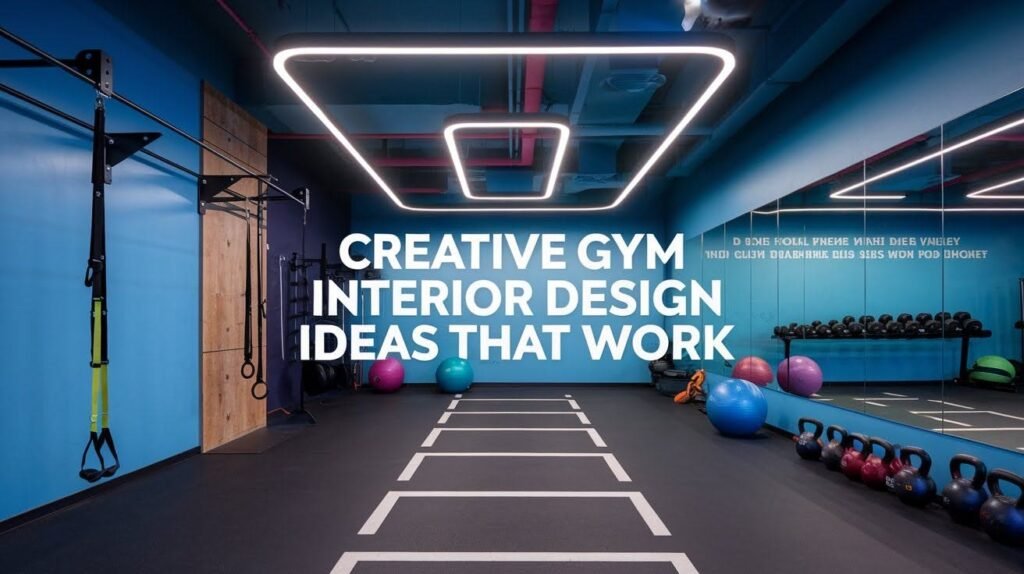Struggling to create a gym space that actually motivates people?
You’re not alone. Most gym owners make the same mistake – they focus on equipment and forget about the environment.
I’ve spent five years helping fitness businesses change boring spaces into places people want to visit. In this guide, you’ll find 45 proven interior design ideas across five different styles, from simple black and white to nature-inspired spaces.
Here’s what I’ll show you: specific design elements that work, real costs, common mistakes to avoid, and tips from successful gym owners. You’ll also learn smart solutions for small spaces and tech tools that help any design.
My advice comes from working with over 200 fitness facilities nationwide. I’ve seen what works and what wastes money.
Ready to improve your space? Let’s look at designs that make people want to work out.
Why Interior Design Matters for Gyms Today
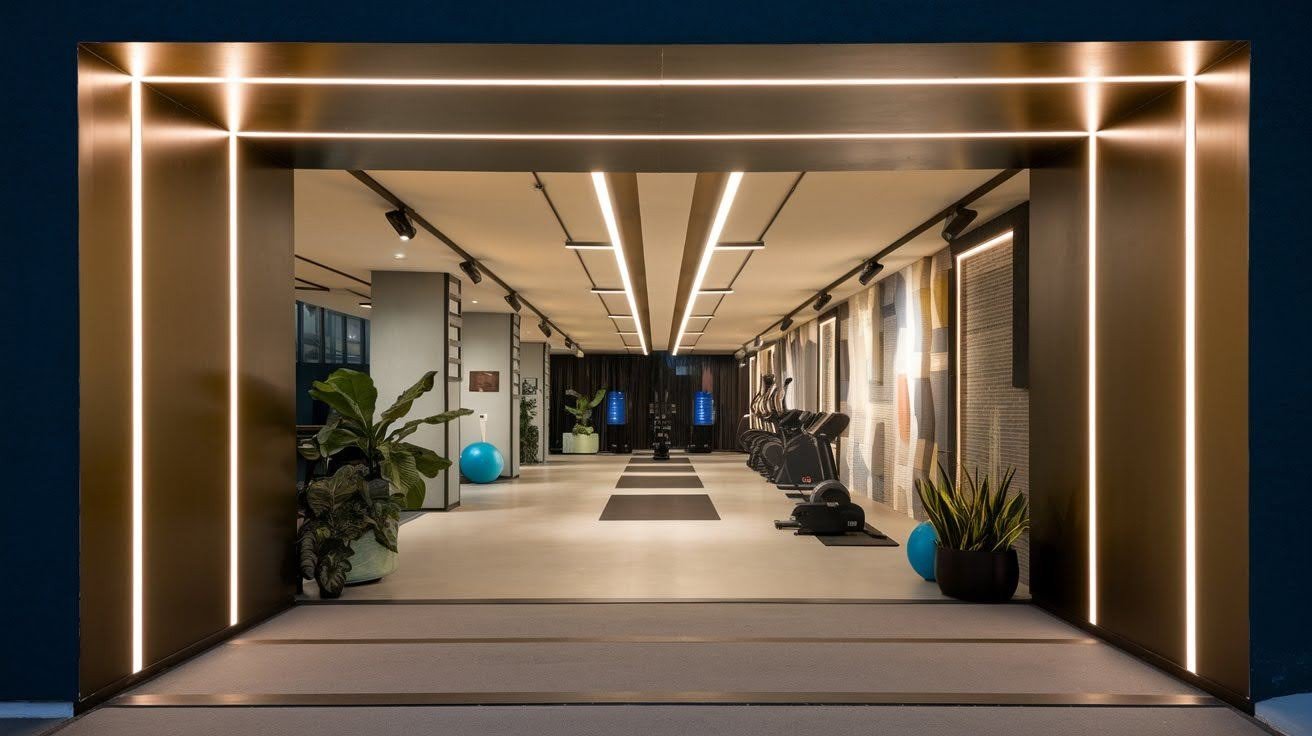
The fitness industry changed forever after 2020. People got used to working out at home. They built home gyms. Downloaded apps. Bought Pelotons.
Now? You need to give them a reason to leave their house.
A well-designed gym does three things:
- Creates an emotional connection with members
- Encourages longer workout sessions
- Gets people posting on social media (free marketing)
Think about it. When was the last time you saw someone post a mirror selfie from a boring gym? Never. But show them a space with neon lights, living walls, or industrial charm?
They’ll be posting before their first rep.
Core Elements of Creative Gym Interior Design
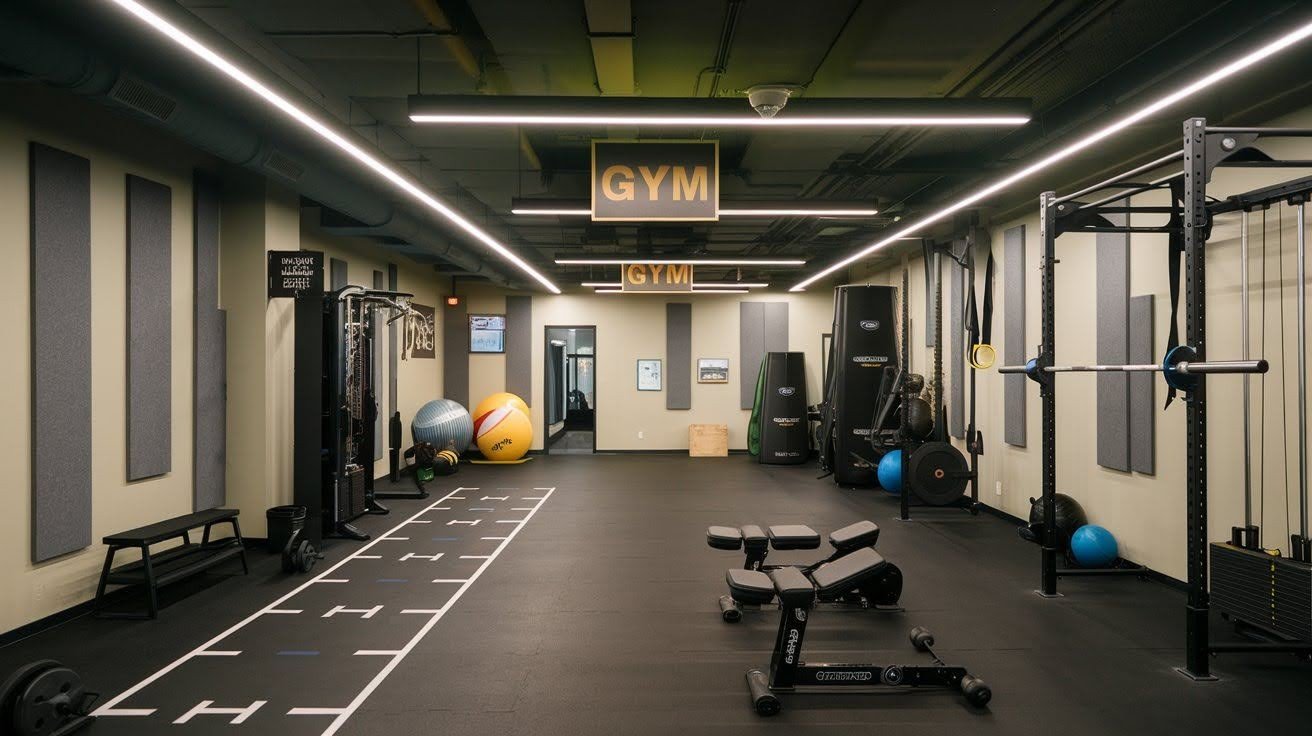
Before I cover specific styles, let me share what every great gym design needs:
- Lighting comes first. Bad lighting kills motivation. Good lighting makes everyone look stronger.
- Zones save space. Separate your cardio, strength, and stretching areas. Clear boundaries prevent chaos.
- Materials matter. Choose surfaces that can handle sweat, weights, and constant cleaning.
- Sound design matters too. You need zones where music pumps people up and quiet corners for stretching.
Now let’s look at the styles that actually work.
Simple Black and White
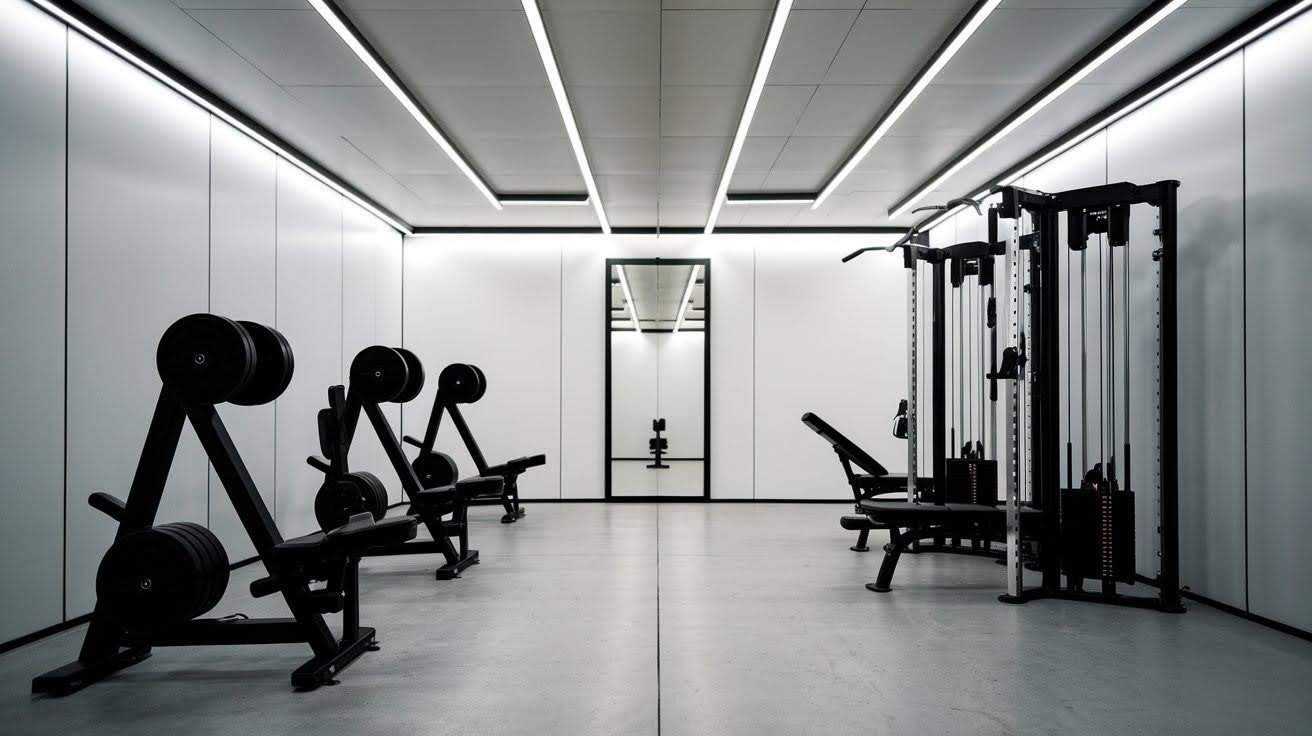
Less is more, especially when you’re dealing with heavy equipment and sweaty people. The simple approach works because it removes distractions. Members focus on their workout, not busy patterns or clashing colors.
Here’s how to nail this look:
- Black equipment with white walls creates a classic combo that never fails. The contrast looks good without being harsh.
- Built-in LED lighting works better than overhead fluorescents. Install LED strips along walls and ceilings for a clean, modern effect.
- Concrete or smooth flooring is tough and easy to clean. It looks expensive without the price tag.
- Simple black signage provides branding that doesn’t scream for attention.
- Hidden storage and fold-away benches keep surfaces clear. Everything has a place.
- One piece of art per room prevents visual overload. A single bold piece is enough.
- Simple floor patterns in black and white add interest without wall clutter.
- Framed mirrors with thin edges look intentional, not cheap. Choose thin black frames.
- Grey walls create depth without color chaos.
Pro tip: Use different textures to add interest. Smooth walls, rough concrete, soft rubber flooring.
Industrial-Style Gym Design
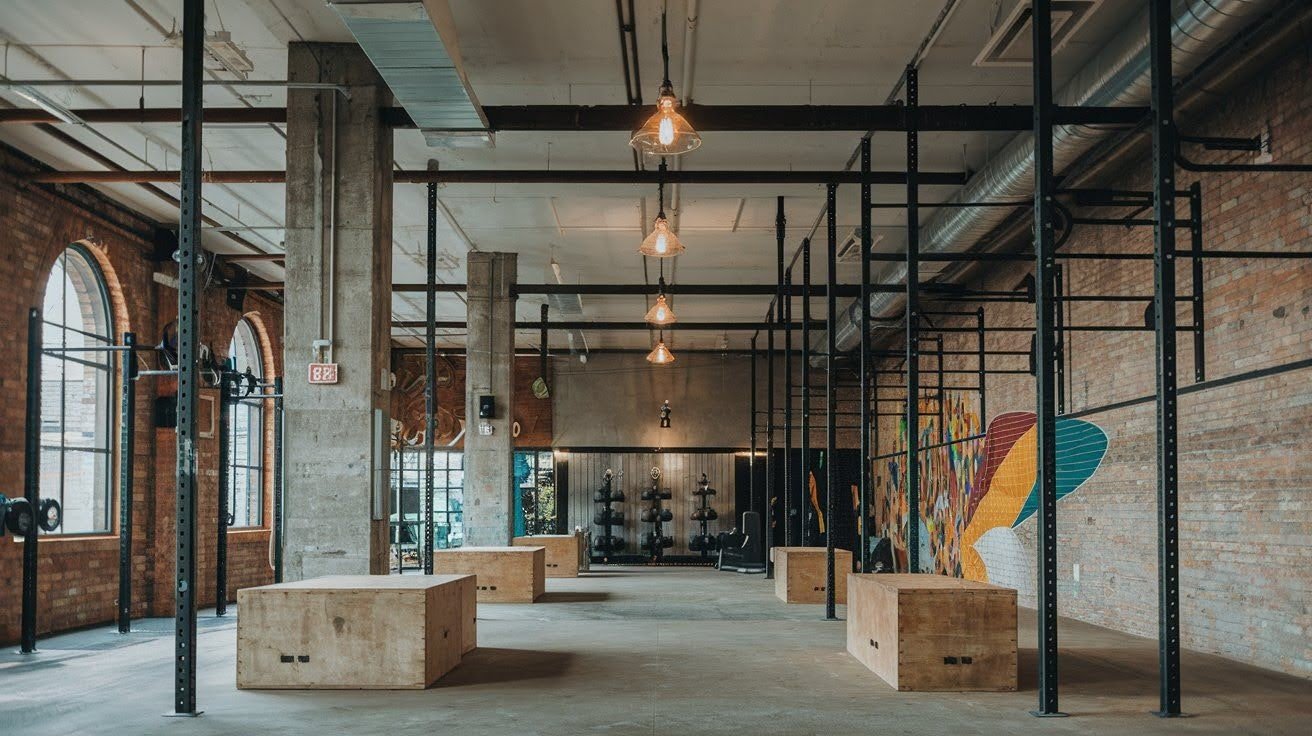
This style shows strength and authenticity.
Industrial design works in gyms because it celebrates the raw nature of lifting. No pretense. Just pure function. Industrial design works because it feels honest about what happens here, people lifting heavy things.
- Exposed brick walls with steel frames work best when you leave those brick walls bare and add steel beam accents.
- Exposed pipes and ducts mean you don’t hide the HVAC. Paint it black and make it part of the design.
- Reclaimed wood benches and racks add warmth to cold industrial spaces.
- Old metal lockers are worth hunting down from old schools. They look great in photos.
- Edison bulb lighting creates warm light that makes the space feel less warehouse, more boutique.
- Black steel squat racks fit the theme perfectly with their raw steel appearance.
- Raw concrete columns left untouched embrace structural elements instead of hiding them.
- Large windows bring in natural light that softens the hard edges.
- Wall murals on one side work well when you hire a local artist. Support your community while creating a focal point.
The key? Balance rough with refined. Too much raw industry feels like a construction site.
Nature-Inspired Interior Gyms
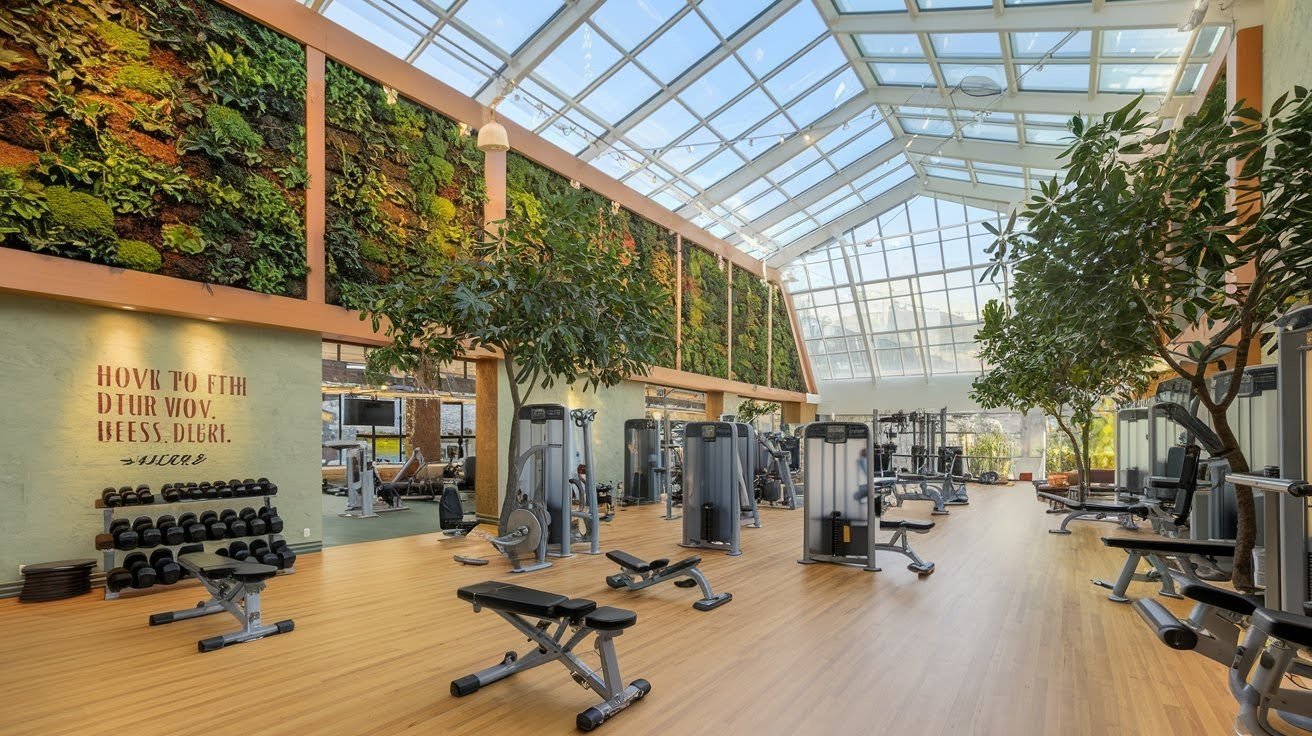
Bringing the outdoors in reduces stress and improves mood. Science backs this up. Studies show that natural elements in workout spaces increase endurance and reduce how hard exercise feels.
- Living plant walls or hanging plants improve air quality and look amazing in photos.
- Bamboo flooring for yoga and meditation zones is warm, sustainable, and perfect for barefoot activities.
- Natural light from skylights beats artificial lighting. Nothing matches real sunlight for energy and mood.
- Indoor trees or potted palms create natural room dividers with large plants.
- Earth-tone colors in green, clay, and sand calm the nervous system between intense sets.
- Natural textures like rope wall dividers or mats feel good to touch and look organic.
- Essential oil diffusers work with subtle scents like eucalyptus or peppermint that energize without overwhelming.
- Cork walls for pinning motivation or programs are functional and natural. Let members personalize their space.
- Nature sounds in sound systems add gentle water or wind sounds in stretching areas.
Warning: Don’t go overboard. You’re designing a gym, not a jungle.
Artistic and Bold Fitness Spaces
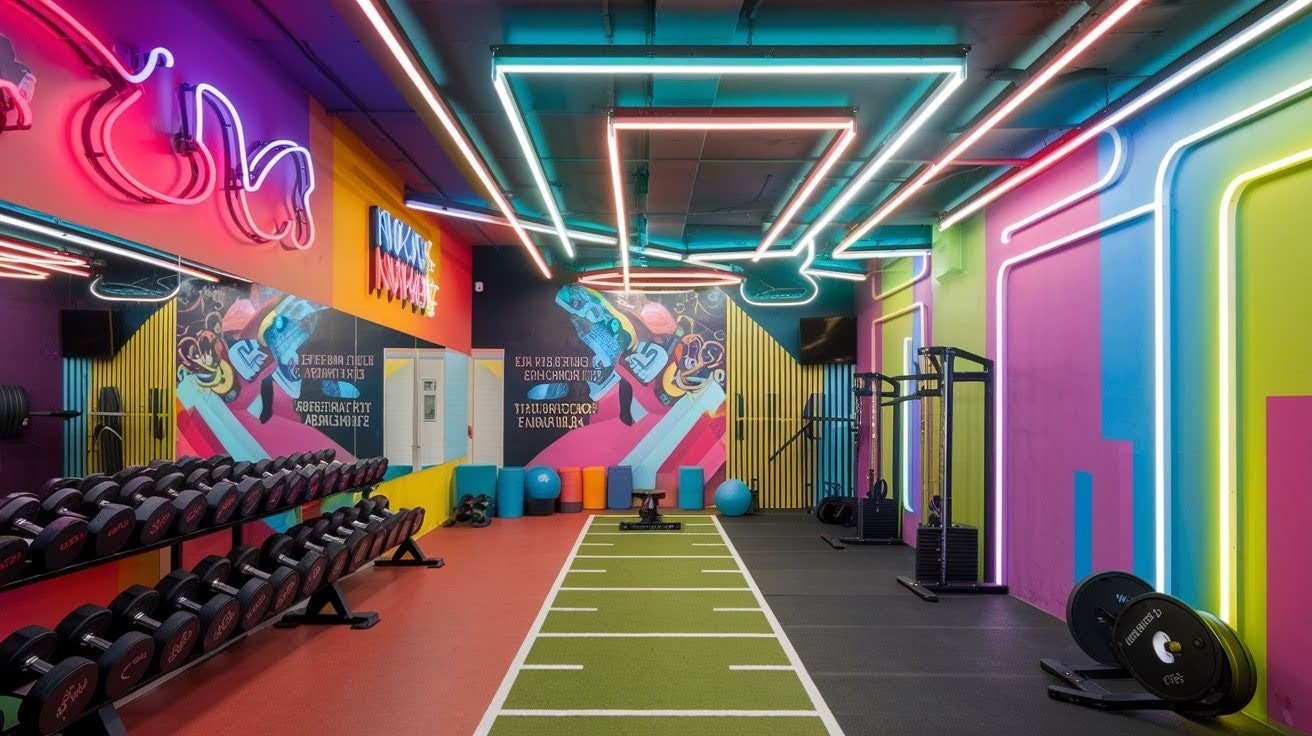
Some gyms need to make a statement. If your members are young, social media-savvy, and value experience over everything else, go bold.
- Neon motivational signs like “No Days Off” use LED neon that’s energy-efficient and creates that Instagram glow.
- Color-blocked equipment zones use bright colors to define areas. Red for strength. Blue for cardio.
- Custom street art murals work when you hire local artists. Make your gym a landmark.
- Colored LED lights for different moods can be programmed for different times of day or workout types.
- Wall decals in removable vinyl let you change designs seasonally.
- Statement ceilings that are painted or textured matter because people spend a lot of time looking up during bench press.
- Mirror walls for dance studios break up large mirror surfaces while maintaining function.
- Themed corners like retro boxing or 80s vibes create Instagram-worthy spots throughout your space.
- Light-reactive floors or glow-in-dark trim add high-tech touches that wow members.
Remember: Bold doesn’t mean chaotic. Choose one main element per area.
Compact and Smart Home Gym Design
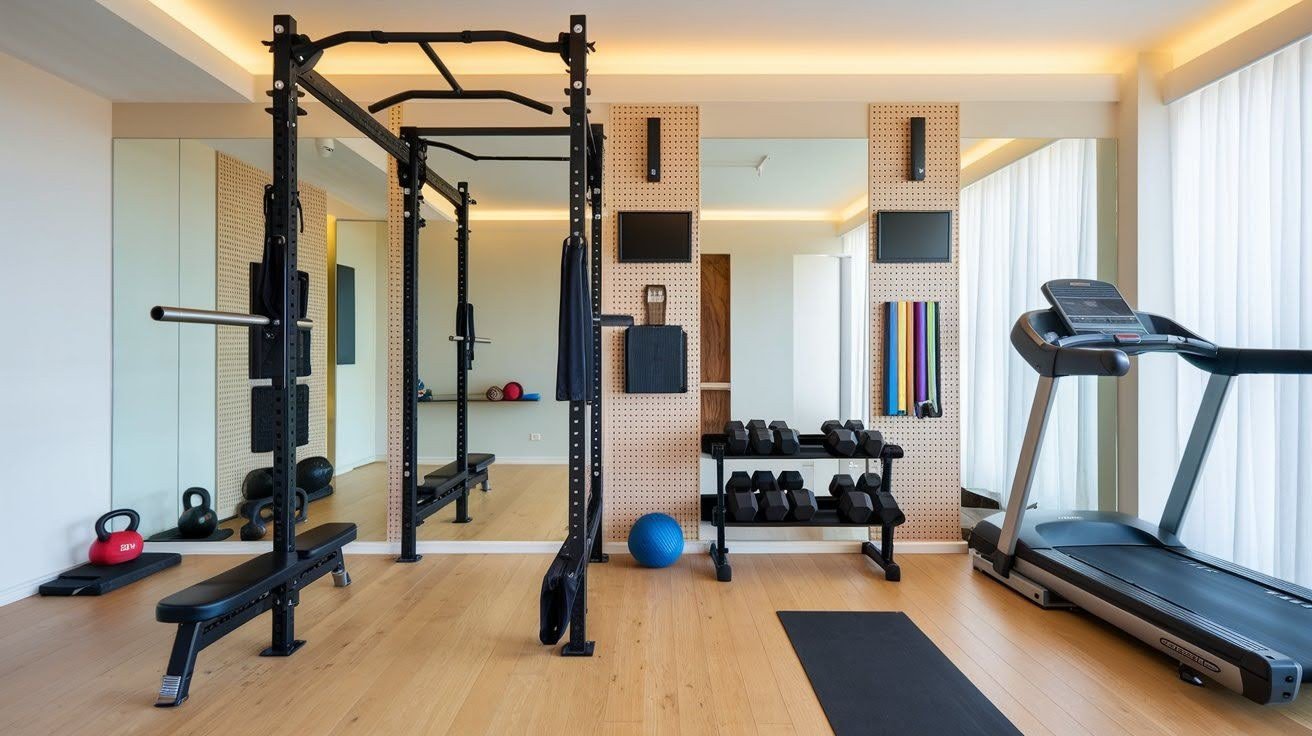
Not everyone has 5,000 square feet. Small spaces need smart solutions that make the most of every inch.
- Wall racks for weights and accessories make you think up, not out.
- Fold-down squat racks save space with equipment that tucks away.
- Multi-functional furniture like benches with storage means every piece should serve multiple purposes.
- Wall-mounted mirrors with screens like Tonal combine reflection and tech instruction.
- Pull-out floor panels give you different flooring for different activities in the same space.
- Overhead storage for mats and towels keeps floor space clear for movement.
- Pegboard organization for resistance bands creates visual organization that looks intentional.
- Magnetic walls to clip metal gear allow quick access and easy reorganization.
- Compact corner cardio machines like curved treadmills and bikes use space efficiently.
Small Gym? Smart Design Tricks
Space constraints don’t have to limit creativity.
- Use mirrors strategically. Place them to reflect your best features and create depth.
- Choose light colors. They make spaces feel larger and more open.
- Create zones with flooring. Different materials define areas without walls.
- Go vertical with storage. Wall-mounted everything keeps floors clear.
- Use lighting to expand space. Bright, even lighting makes rooms feel bigger.
Tools & Tech That Improve Design
3D design software like SketchUp helps you see before you build. Smart lighting systems let you adjust mood throughout the day. Sound control technology manages noise between zones.
Air purification systems keep spaces fresh without windows. Climate control zones maintain different temperatures for different activities.
Real-World Examples of Creative Gym Interior Design
- 1Rebel in London nails the nightclub-meets-gym look with dark spaces and neon accents.
- Equinox proves that luxury gym design drives premium pricing.
- Barry’s Bootcamp uses theatrical lighting and dark rooms to create intensity.
- SoulCycle turns cycling into a spiritual experience through design.
- F45 creates community through open, bright, and welcoming spaces.
- Each succeeds because their design matches their brand promise.
Tips from Interior Designers and Gym Owners
Start with your ideal member. Design for who you want to attract, not everyone. Budget 15-20% of your total investment for interior design. Cheap design looks cheap.
Plan for growth. Design systems that can expand as your business grows. Test materials in real conditions. Gym environments are harsh. Not all materials survive.
Hire professionals for complex elements. DIY works for small touches, not major installations. Document everything. Take photos throughout the installation for future repairs and expansions.
SEO Tips If You’re Designing a Gym for a Business
Local SEO starts with great photos. Professional interior photography improves Google rankings.
Name your spaces creatively. “The Strength Cave” ranks better than “Weight Room.” Create content around your design choices. Blog about your materials, colors, and inspiration.
Tag local suppliers and artists. Build community connections that improve local search presence. Use proper markup for business photos. Help Google understand your image content.
Encourage member photos. User-generated content signals engagement to search engines.
Document design changes. Before/after content generates links and shares.
Conclusion
Your gym’s success depends on more than just equipment.
Great interior design creates emotional connections. It makes members feel motivated the moment they walk in. More importantly, it gives them a reason to choose your gym over home workouts.
I’ve shown you 45 specific design ideas that actually work. Pick the style that matches your brand and budget. Start with one area and expand from there.
Remember these key points: lighting sets the mood, zones prevent chaos, and materials must handle real gym conditions. Don’t try to copy every trend you see on Instagram.
Focus on your members’ needs first. Design for function, then add beauty. The fitness industry is competitive. Your space can be your biggest advantage. Make it count.
Ready to start? Choose three ideas from this guide and begin planning today.
Frequently Asked Questions
How much should I budget for gym interior design?
Plan to spend 15-20% of your total gym investment on interior design. A $100,000 gym setup should include $15,000-$20,000 for professional design and materials.
What flooring works best for creative gym designs?
Rubber flooring with custom patterns offers the best mix of function and style. Concrete looks modern but needs proper sealing to handle moisture and impact.
Can I redesign my existing gym without major construction?
Yes, focus on lighting upgrades, wall graphics, and equipment placement changes first. These create dramatic visual impact without structural modifications or permits.
Which design style attracts the most members?
Industrial and simple designs have the broadest appeal across age groups. Bold artistic styles work best for younger people and boutique fitness concepts.
How long does a complete gym interior renovation take?
Most gym redesigns take 4-6 weeks from planning to completion. Simple updates like lighting and graphics can be done in 1-2 weeks during off-peak hours


